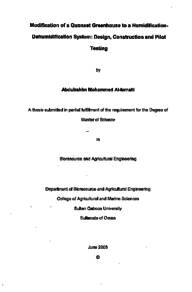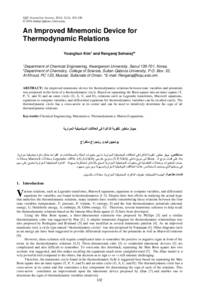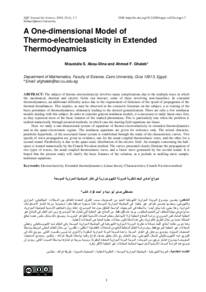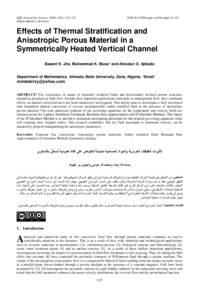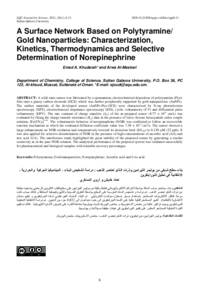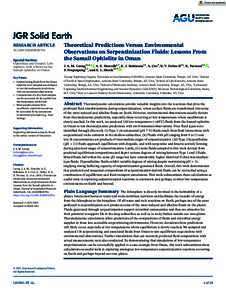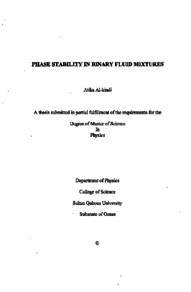وثيقة
Modification of a quonset greenhouse to a humidification-dehumidification system : design, construction and pilot testing
الناشر
Sultan Qaboos University
ميلادي
2003
اللغة
الأنجليزية
الملخص الإنجليزي
Prolonged aridity in the Sultanate has resulted in freshwater deficit in some parts of the country. In coastal areas, the aridity coupled with overpumping of groundwater have often resulted in seawater intrusion. Looking for alternatives to provide freshwater for domestic, industrial and agricultural purposes is an ultimate goal for the government. An overview of these alternatives is described in this study. The use of solar radiation in greenhouses to desalinate saline/brackish water was proposed as an alternative to provide freshwater for irrigation. This study aims at constructing and preliminary testing a humidification-dehumidification system in a Quonset greenhouse for producing freshwater. The greenhouse was constructed and tested at the Agricultural Experiment Station (AES) of Sultan Qaboos University.
This greenhouse was modified to work with two humidifiers (i.e., evaporating pads), to increase water vapor inside the greenhouse as much as possible, and two dehumidifiers (i.e., condensers) to condense this water vapor. After evaporation, water leaving the humidifiers was cooler than the incoming water. This cooled water was pumped to the two dehumidifiers and acted as a coolant.
Preliminary testing of the performance of the greenhouse showed an increase in the amount of water vapor after the second humidifier. The temperature of the dehumidifiers was always lower than the dew-point temperature of the air passing through them. This meant that there was a potential for condensation. However, condensation was insufficient to result in a measurable quantity.
Possible reasons for this insufficient condensation were investigated. Finally, recommendations for improvements of the humidifiers and dehumidifiers were suggested.
المجموعة
URL المصدر
الملخص العربي
تسبب الجفاف في سلطنة عمان إلى شح في المياه العذبة في بعض الأجزاء من البلاد، ونجد في المناطق الساحلية أن الجفاف والضخ المفرط للمياه الجوفية قد نتج عنه تداخل مياه البحر بالمياه الجوفية . إن البحث عن بدائل لتوفير المياه الصالحة للاستخدامات البشرية والصناعية والزراعية هو أحد أولويات الحكومة ، و قد تم التعرض في هذه الدراسة لنبذة من هذه البدائل. واقترح استخدام الإشعاع الشمسي في البيوت المحمية لتحلية المياه المالحة أو العكرة ليكون أحد البدائل لتوفير المياه الصالحة للري ، وتهدف هذه الدراسة إلى إنشاء وإجراء الفحص المبدئي لأنظمة التبخير و التكثيف في أحد البيوت المحمية من نوع Quonset لمعالجة المياه بهدف إستخدامها لأغراض الري .
وقد تم تشييد و فحص هذا البيت المحمي في محطة التجارب الزراعية في جامعة السلطان قابوس ، و زود هذا البيت بجداري تبخیر (وسائد تبرید) الزيادة بخار الماء داخل البيت المحمي إلى أقصى حد ممكن ، وكذلك تم إنشاء مكثفين لتكثيف هذا البخار ، وبعد عملية التبخير وجد أن الماء الخارج من جداري التبريد كان أبرد من الماء الداخل إليهما ، ولذلك تم ضخ هذا الماء البارد إلى المكثفين ليعمل على تبريدهما.
إن الفحص المبدئي لهذا البيت المحمي أظهر زيادة في كمية بخار الماء بعد جدار التبخير الثاني مقارنة بالجدار الأول ، وإن درجة حرارة المكثفين كانت دائما أقل من درجة حرارة التشبع للهواء المار خلالهما ، وهذا يعني أن التكثيف البخار الماء كان يفترض حدوثه ، في حين وجد أن التكثيف كان غير كاف لينتج كمية من الماء يمكن قياسها.
إن الأسباب المحتملة للكمية القليلة من الماء المتكثف قد تم مناقشتها ، وأخيرا تم اقتراح بعض التوصيات لتحسين أداء جداري التبخير والمكثفين.
وقد تم تشييد و فحص هذا البيت المحمي في محطة التجارب الزراعية في جامعة السلطان قابوس ، و زود هذا البيت بجداري تبخیر (وسائد تبرید) الزيادة بخار الماء داخل البيت المحمي إلى أقصى حد ممكن ، وكذلك تم إنشاء مكثفين لتكثيف هذا البخار ، وبعد عملية التبخير وجد أن الماء الخارج من جداري التبريد كان أبرد من الماء الداخل إليهما ، ولذلك تم ضخ هذا الماء البارد إلى المكثفين ليعمل على تبريدهما.
إن الفحص المبدئي لهذا البيت المحمي أظهر زيادة في كمية بخار الماء بعد جدار التبخير الثاني مقارنة بالجدار الأول ، وإن درجة حرارة المكثفين كانت دائما أقل من درجة حرارة التشبع للهواء المار خلالهما ، وهذا يعني أن التكثيف البخار الماء كان يفترض حدوثه ، في حين وجد أن التكثيف كان غير كاف لينتج كمية من الماء يمكن قياسها.
إن الأسباب المحتملة للكمية القليلة من الماء المتكثف قد تم مناقشتها ، وأخيرا تم اقتراح بعض التوصيات لتحسين أداء جداري التبخير والمكثفين.
قالب العنصر
الرسائل والأطروحات الجامعية

